Auckland McDonalds Supply Chain: An In-depth Analysis Report
VerifiedAdded on 2021/04/21
|17
|8088
|239
Report
AI Summary
This report provides a comprehensive analysis of McDonald's supply chain operations in Auckland, New Zealand. It employs a mixed methodology, combining primary data from interviews with five restaurant personnel and secondary data from books, journals, and research reports. The study aims to identify the factors contributing to the efficiency of McDonald's supply chain, exploring the application of supply chain theories to understand its success. The research utilizes case study analysis to examine the company's best practices in supply chain management and overcome challenges. The primary interview data undergoes thematic analysis to identify key themes, which are then explored in depth, integrating insights from both primary and secondary sources. The report covers the company background, significance, aims, objectives, research scope, and methodology, including interview and case study analysis, followed by findings, analysis, and discussion. It concludes with recommendations for effective supply chain network implementation in food retail chains.
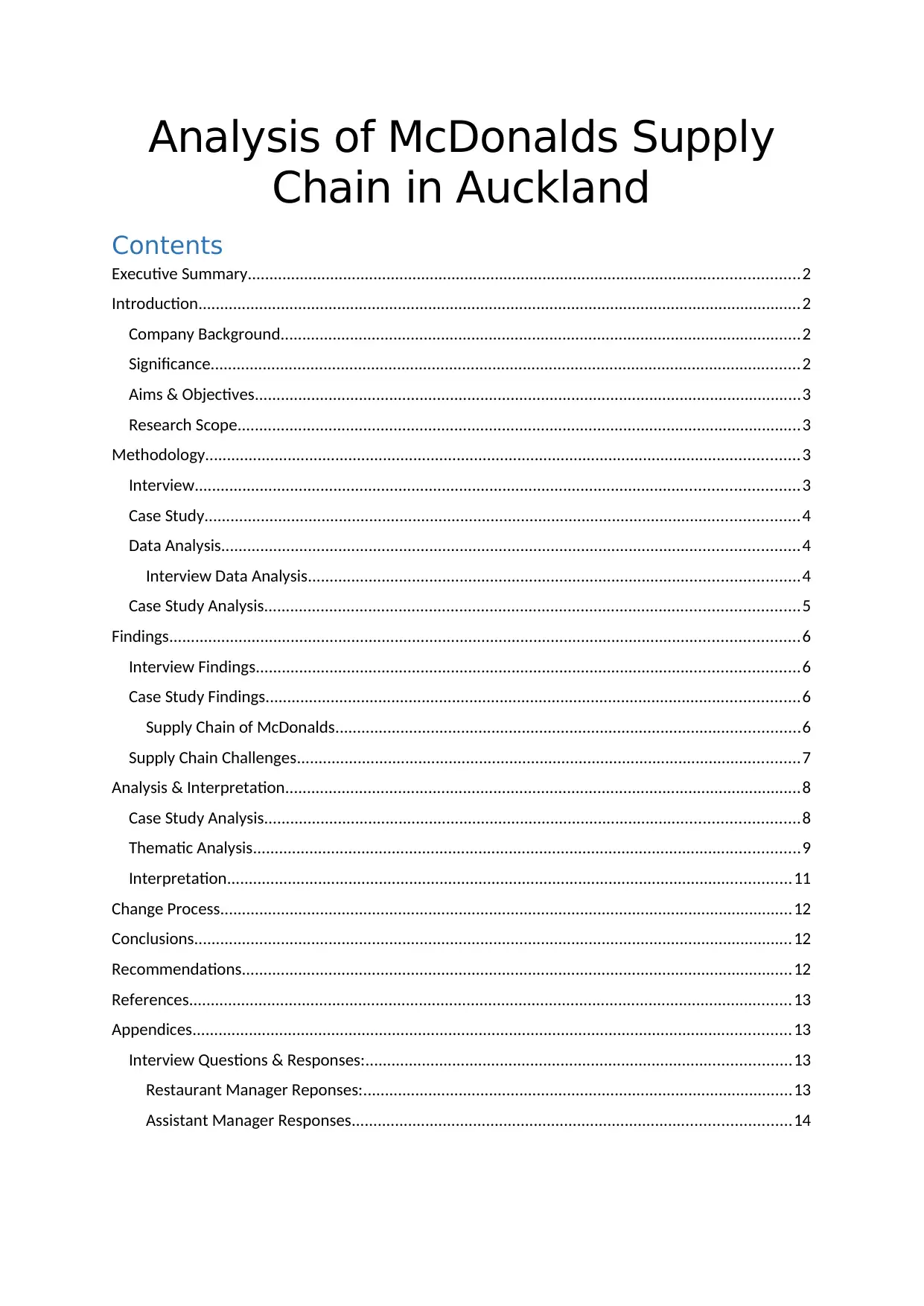
Analysis of McDonalds Supply
Chain in Auckland
Contents
Executive Summary...............................................................................................................................2
Introduction...........................................................................................................................................2
Company Background........................................................................................................................2
Significance........................................................................................................................................2
Aims & Objectives..............................................................................................................................3
Research Scope..................................................................................................................................3
Methodology.........................................................................................................................................3
Interview...........................................................................................................................................3
Case Study.........................................................................................................................................4
Data Analysis.....................................................................................................................................4
Interview Data Analysis.................................................................................................................4
Case Study Analysis...........................................................................................................................5
Findings.................................................................................................................................................6
Interview Findings.............................................................................................................................6
Case Study Findings...........................................................................................................................6
Supply Chain of McDonalds...........................................................................................................6
Supply Chain Challenges....................................................................................................................7
Analysis & Interpretation.......................................................................................................................8
Case Study Analysis...........................................................................................................................8
Thematic Analysis..............................................................................................................................9
Interpretation..................................................................................................................................11
Change Process....................................................................................................................................12
Conclusions..........................................................................................................................................12
Recommendations...............................................................................................................................12
References...........................................................................................................................................13
Appendices..........................................................................................................................................13
Interview Questions & Responses:..................................................................................................13
Restaurant Manager Reponses:...................................................................................................13
Assistant Manager Responses.....................................................................................................14
Chain in Auckland
Contents
Executive Summary...............................................................................................................................2
Introduction...........................................................................................................................................2
Company Background........................................................................................................................2
Significance........................................................................................................................................2
Aims & Objectives..............................................................................................................................3
Research Scope..................................................................................................................................3
Methodology.........................................................................................................................................3
Interview...........................................................................................................................................3
Case Study.........................................................................................................................................4
Data Analysis.....................................................................................................................................4
Interview Data Analysis.................................................................................................................4
Case Study Analysis...........................................................................................................................5
Findings.................................................................................................................................................6
Interview Findings.............................................................................................................................6
Case Study Findings...........................................................................................................................6
Supply Chain of McDonalds...........................................................................................................6
Supply Chain Challenges....................................................................................................................7
Analysis & Interpretation.......................................................................................................................8
Case Study Analysis...........................................................................................................................8
Thematic Analysis..............................................................................................................................9
Interpretation..................................................................................................................................11
Change Process....................................................................................................................................12
Conclusions..........................................................................................................................................12
Recommendations...............................................................................................................................12
References...........................................................................................................................................13
Appendices..........................................................................................................................................13
Interview Questions & Responses:..................................................................................................13
Restaurant Manager Reponses:...................................................................................................13
Assistant Manager Responses.....................................................................................................14
Paraphrase This Document
Need a fresh take? Get an instant paraphrase of this document with our AI Paraphraser
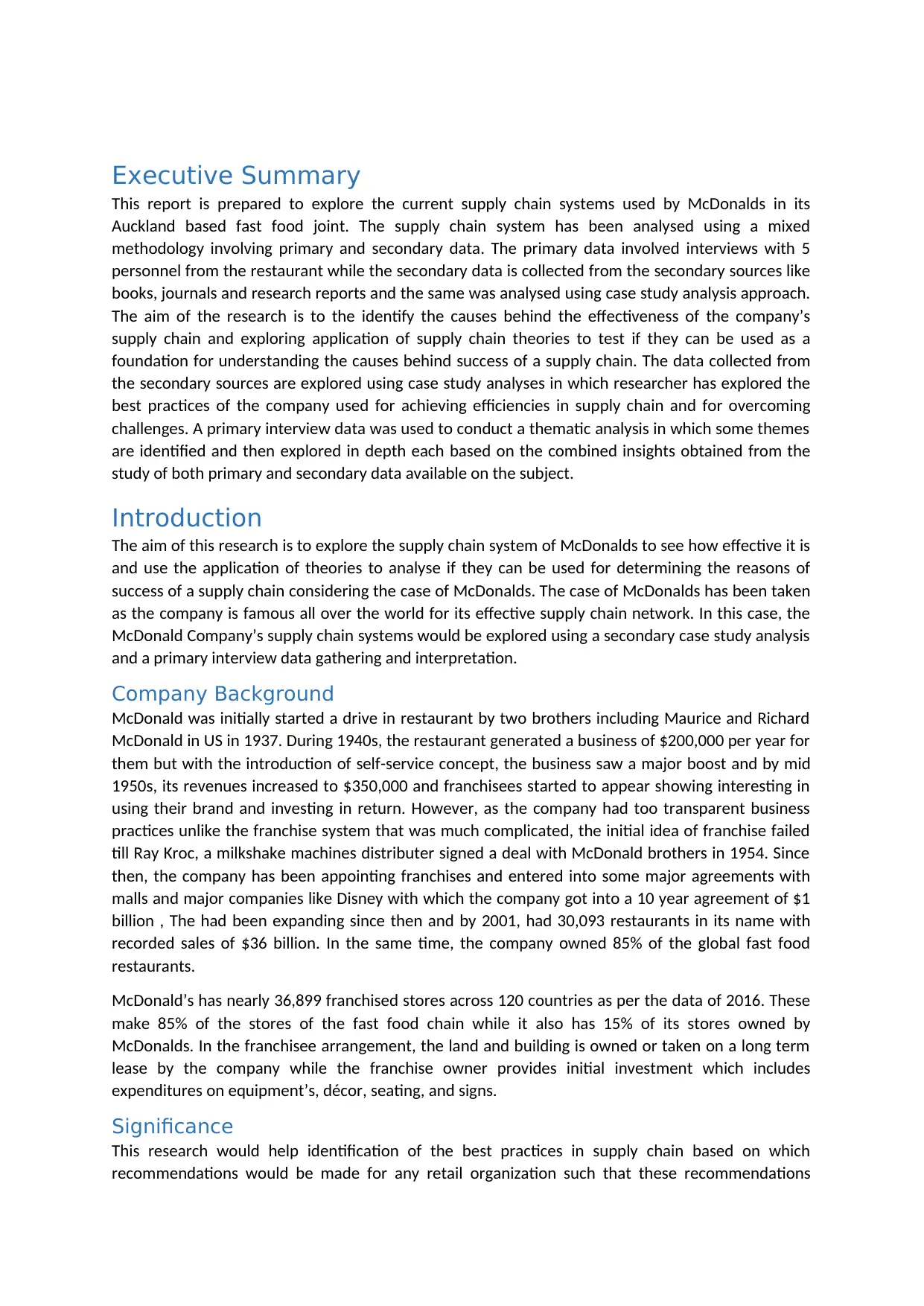
Executive Summary
This report is prepared to explore the current supply chain systems used by McDonalds in its
Auckland based fast food joint. The supply chain system has been analysed using a mixed
methodology involving primary and secondary data. The primary data involved interviews with 5
personnel from the restaurant while the secondary data is collected from the secondary sources like
books, journals and research reports and the same was analysed using case study analysis approach.
The aim of the research is to the identify the causes behind the effectiveness of the company’s
supply chain and exploring application of supply chain theories to test if they can be used as a
foundation for understanding the causes behind success of a supply chain. The data collected from
the secondary sources are explored using case study analyses in which researcher has explored the
best practices of the company used for achieving efficiencies in supply chain and for overcoming
challenges. A primary interview data was used to conduct a thematic analysis in which some themes
are identified and then explored in depth each based on the combined insights obtained from the
study of both primary and secondary data available on the subject.
Introduction
The aim of this research is to explore the supply chain system of McDonalds to see how effective it is
and use the application of theories to analyse if they can be used for determining the reasons of
success of a supply chain considering the case of McDonalds. The case of McDonalds has been taken
as the company is famous all over the world for its effective supply chain network. In this case, the
McDonald Company’s supply chain systems would be explored using a secondary case study analysis
and a primary interview data gathering and interpretation.
Company Background
McDonald was initially started a drive in restaurant by two brothers including Maurice and Richard
McDonald in US in 1937. During 1940s, the restaurant generated a business of $200,000 per year for
them but with the introduction of self-service concept, the business saw a major boost and by mid
1950s, its revenues increased to $350,000 and franchisees started to appear showing interesting in
using their brand and investing in return. However, as the company had too transparent business
practices unlike the franchise system that was much complicated, the initial idea of franchise failed
till Ray Kroc, a milkshake machines distributer signed a deal with McDonald brothers in 1954. Since
then, the company has been appointing franchises and entered into some major agreements with
malls and major companies like Disney with which the company got into a 10 year agreement of $1
billion , The had been expanding since then and by 2001, had 30,093 restaurants in its name with
recorded sales of $36 billion. In the same time, the company owned 85% of the global fast food
restaurants.
McDonald’s has nearly 36,899 franchised stores across 120 countries as per the data of 2016. These
make 85% of the stores of the fast food chain while it also has 15% of its stores owned by
McDonalds. In the franchisee arrangement, the land and building is owned or taken on a long term
lease by the company while the franchise owner provides initial investment which includes
expenditures on equipment’s, décor, seating, and signs.
Significance
This research would help identification of the best practices in supply chain based on which
recommendations would be made for any retail organization such that these recommendations
This report is prepared to explore the current supply chain systems used by McDonalds in its
Auckland based fast food joint. The supply chain system has been analysed using a mixed
methodology involving primary and secondary data. The primary data involved interviews with 5
personnel from the restaurant while the secondary data is collected from the secondary sources like
books, journals and research reports and the same was analysed using case study analysis approach.
The aim of the research is to the identify the causes behind the effectiveness of the company’s
supply chain and exploring application of supply chain theories to test if they can be used as a
foundation for understanding the causes behind success of a supply chain. The data collected from
the secondary sources are explored using case study analyses in which researcher has explored the
best practices of the company used for achieving efficiencies in supply chain and for overcoming
challenges. A primary interview data was used to conduct a thematic analysis in which some themes
are identified and then explored in depth each based on the combined insights obtained from the
study of both primary and secondary data available on the subject.
Introduction
The aim of this research is to explore the supply chain system of McDonalds to see how effective it is
and use the application of theories to analyse if they can be used for determining the reasons of
success of a supply chain considering the case of McDonalds. The case of McDonalds has been taken
as the company is famous all over the world for its effective supply chain network. In this case, the
McDonald Company’s supply chain systems would be explored using a secondary case study analysis
and a primary interview data gathering and interpretation.
Company Background
McDonald was initially started a drive in restaurant by two brothers including Maurice and Richard
McDonald in US in 1937. During 1940s, the restaurant generated a business of $200,000 per year for
them but with the introduction of self-service concept, the business saw a major boost and by mid
1950s, its revenues increased to $350,000 and franchisees started to appear showing interesting in
using their brand and investing in return. However, as the company had too transparent business
practices unlike the franchise system that was much complicated, the initial idea of franchise failed
till Ray Kroc, a milkshake machines distributer signed a deal with McDonald brothers in 1954. Since
then, the company has been appointing franchises and entered into some major agreements with
malls and major companies like Disney with which the company got into a 10 year agreement of $1
billion , The had been expanding since then and by 2001, had 30,093 restaurants in its name with
recorded sales of $36 billion. In the same time, the company owned 85% of the global fast food
restaurants.
McDonald’s has nearly 36,899 franchised stores across 120 countries as per the data of 2016. These
make 85% of the stores of the fast food chain while it also has 15% of its stores owned by
McDonalds. In the franchisee arrangement, the land and building is owned or taken on a long term
lease by the company while the franchise owner provides initial investment which includes
expenditures on equipment’s, décor, seating, and signs.
Significance
This research would help identification of the best practices in supply chain based on which
recommendations would be made for any retail organization such that these recommendations
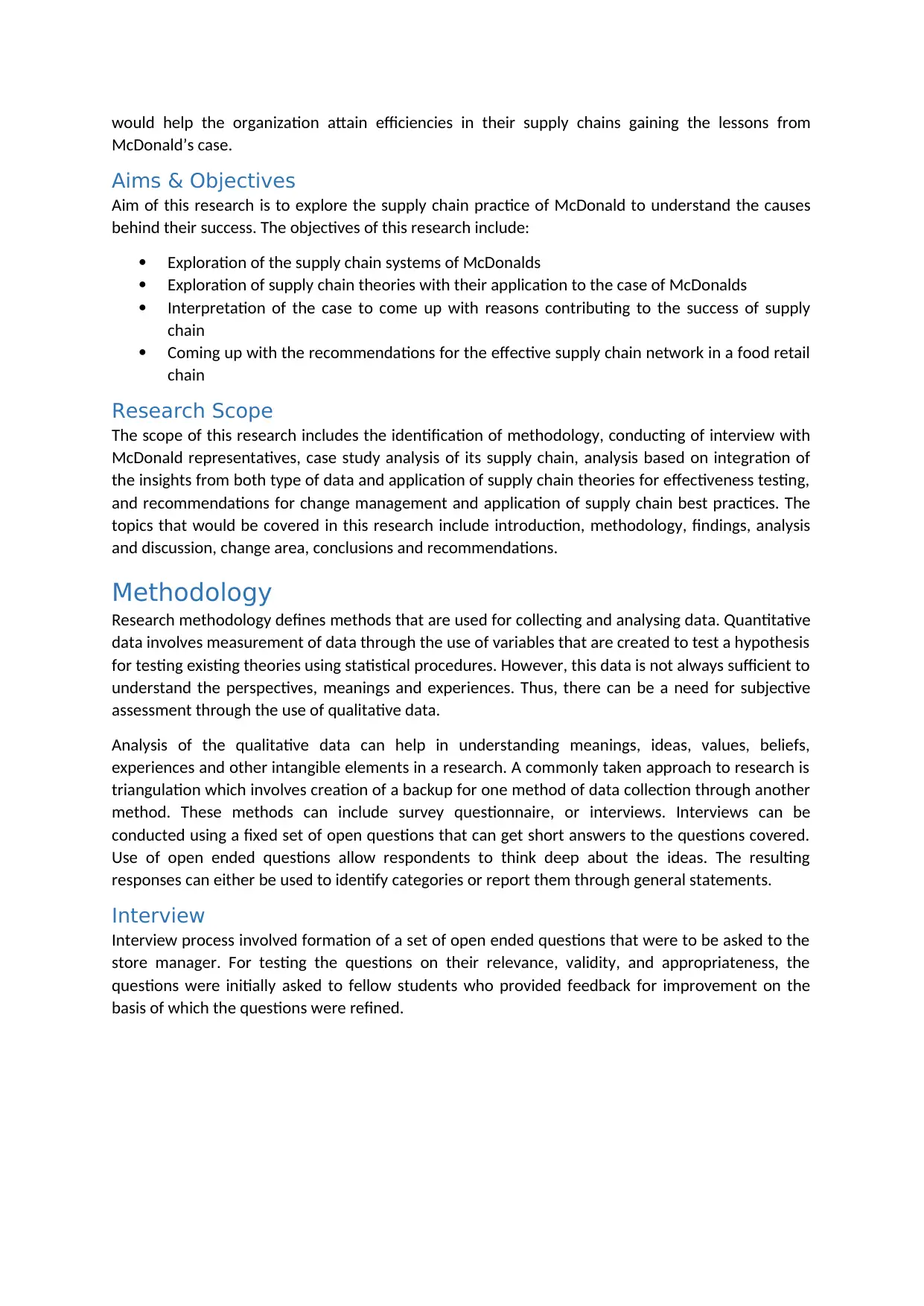
would help the organization attain efficiencies in their supply chains gaining the lessons from
McDonald’s case.
Aims & Objectives
Aim of this research is to explore the supply chain practice of McDonald to understand the causes
behind their success. The objectives of this research include:
Exploration of the supply chain systems of McDonalds
Exploration of supply chain theories with their application to the case of McDonalds
Interpretation of the case to come up with reasons contributing to the success of supply
chain
Coming up with the recommendations for the effective supply chain network in a food retail
chain
Research Scope
The scope of this research includes the identification of methodology, conducting of interview with
McDonald representatives, case study analysis of its supply chain, analysis based on integration of
the insights from both type of data and application of supply chain theories for effectiveness testing,
and recommendations for change management and application of supply chain best practices. The
topics that would be covered in this research include introduction, methodology, findings, analysis
and discussion, change area, conclusions and recommendations.
Methodology
Research methodology defines methods that are used for collecting and analysing data. Quantitative
data involves measurement of data through the use of variables that are created to test a hypothesis
for testing existing theories using statistical procedures. However, this data is not always sufficient to
understand the perspectives, meanings and experiences. Thus, there can be a need for subjective
assessment through the use of qualitative data.
Analysis of the qualitative data can help in understanding meanings, ideas, values, beliefs,
experiences and other intangible elements in a research. A commonly taken approach to research is
triangulation which involves creation of a backup for one method of data collection through another
method. These methods can include survey questionnaire, or interviews. Interviews can be
conducted using a fixed set of open questions that can get short answers to the questions covered.
Use of open ended questions allow respondents to think deep about the ideas. The resulting
responses can either be used to identify categories or report them through general statements.
Interview
Interview process involved formation of a set of open ended questions that were to be asked to the
store manager. For testing the questions on their relevance, validity, and appropriateness, the
questions were initially asked to fellow students who provided feedback for improvement on the
basis of which the questions were refined.
McDonald’s case.
Aims & Objectives
Aim of this research is to explore the supply chain practice of McDonald to understand the causes
behind their success. The objectives of this research include:
Exploration of the supply chain systems of McDonalds
Exploration of supply chain theories with their application to the case of McDonalds
Interpretation of the case to come up with reasons contributing to the success of supply
chain
Coming up with the recommendations for the effective supply chain network in a food retail
chain
Research Scope
The scope of this research includes the identification of methodology, conducting of interview with
McDonald representatives, case study analysis of its supply chain, analysis based on integration of
the insights from both type of data and application of supply chain theories for effectiveness testing,
and recommendations for change management and application of supply chain best practices. The
topics that would be covered in this research include introduction, methodology, findings, analysis
and discussion, change area, conclusions and recommendations.
Methodology
Research methodology defines methods that are used for collecting and analysing data. Quantitative
data involves measurement of data through the use of variables that are created to test a hypothesis
for testing existing theories using statistical procedures. However, this data is not always sufficient to
understand the perspectives, meanings and experiences. Thus, there can be a need for subjective
assessment through the use of qualitative data.
Analysis of the qualitative data can help in understanding meanings, ideas, values, beliefs,
experiences and other intangible elements in a research. A commonly taken approach to research is
triangulation which involves creation of a backup for one method of data collection through another
method. These methods can include survey questionnaire, or interviews. Interviews can be
conducted using a fixed set of open questions that can get short answers to the questions covered.
Use of open ended questions allow respondents to think deep about the ideas. The resulting
responses can either be used to identify categories or report them through general statements.
Interview
Interview process involved formation of a set of open ended questions that were to be asked to the
store manager. For testing the questions on their relevance, validity, and appropriateness, the
questions were initially asked to fellow students who provided feedback for improvement on the
basis of which the questions were refined.
⊘ This is a preview!⊘
Do you want full access?
Subscribe today to unlock all pages.

Trusted by 1+ million students worldwide
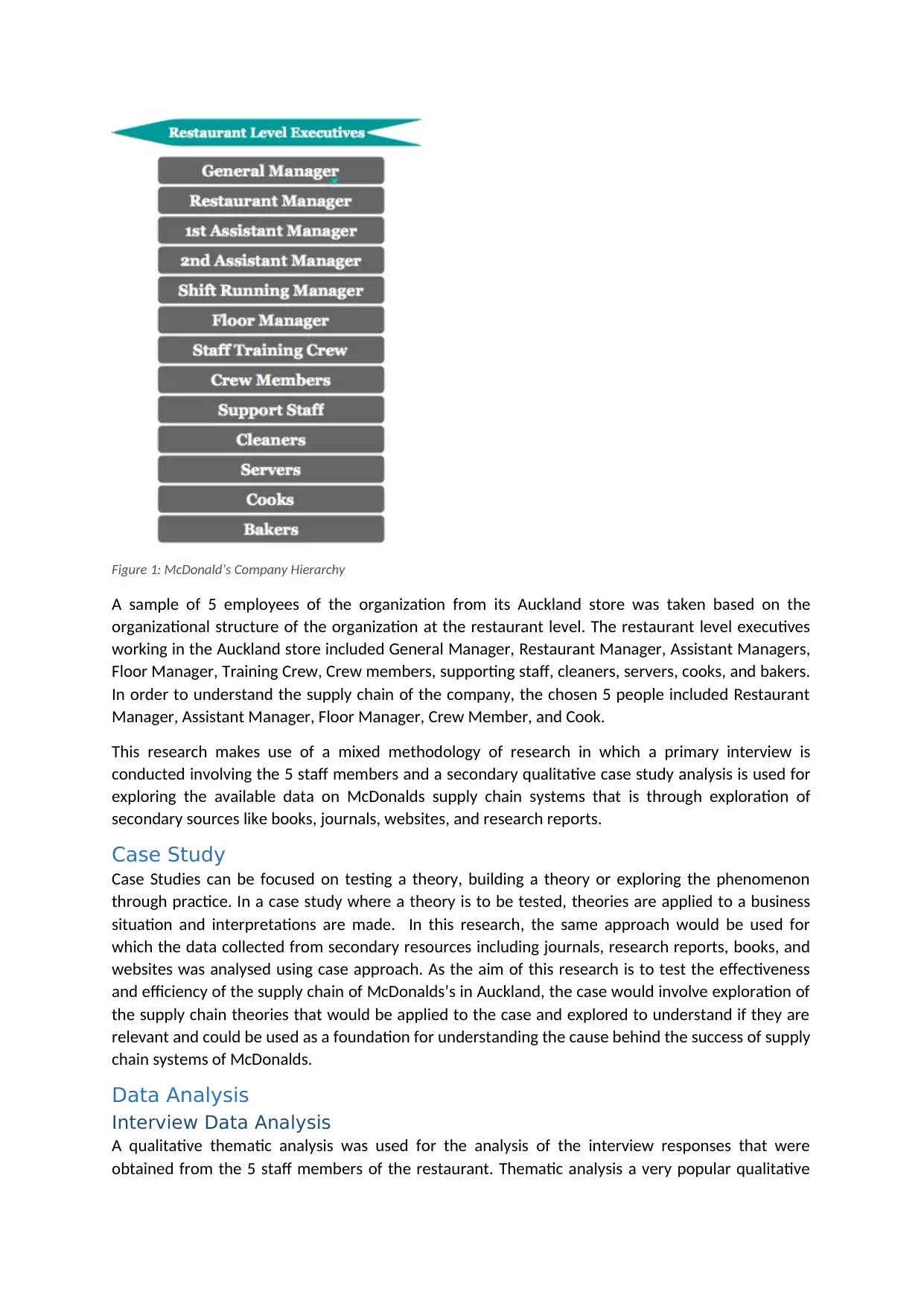
Figure 1: McDonald’s Company Hierarchy
A sample of 5 employees of the organization from its Auckland store was taken based on the
organizational structure of the organization at the restaurant level. The restaurant level executives
working in the Auckland store included General Manager, Restaurant Manager, Assistant Managers,
Floor Manager, Training Crew, Crew members, supporting staff, cleaners, servers, cooks, and bakers.
In order to understand the supply chain of the company, the chosen 5 people included Restaurant
Manager, Assistant Manager, Floor Manager, Crew Member, and Cook.
This research makes use of a mixed methodology of research in which a primary interview is
conducted involving the 5 staff members and a secondary qualitative case study analysis is used for
exploring the available data on McDonalds supply chain systems that is through exploration of
secondary sources like books, journals, websites, and research reports.
Case Study
Case Studies can be focused on testing a theory, building a theory or exploring the phenomenon
through practice. In a case study where a theory is to be tested, theories are applied to a business
situation and interpretations are made. In this research, the same approach would be used for
which the data collected from secondary resources including journals, research reports, books, and
websites was analysed using case approach. As the aim of this research is to test the effectiveness
and efficiency of the supply chain of McDonalds’s in Auckland, the case would involve exploration of
the supply chain theories that would be applied to the case and explored to understand if they are
relevant and could be used as a foundation for understanding the cause behind the success of supply
chain systems of McDonalds.
Data Analysis
Interview Data Analysis
A qualitative thematic analysis was used for the analysis of the interview responses that were
obtained from the 5 staff members of the restaurant. Thematic analysis a very popular qualitative
A sample of 5 employees of the organization from its Auckland store was taken based on the
organizational structure of the organization at the restaurant level. The restaurant level executives
working in the Auckland store included General Manager, Restaurant Manager, Assistant Managers,
Floor Manager, Training Crew, Crew members, supporting staff, cleaners, servers, cooks, and bakers.
In order to understand the supply chain of the company, the chosen 5 people included Restaurant
Manager, Assistant Manager, Floor Manager, Crew Member, and Cook.
This research makes use of a mixed methodology of research in which a primary interview is
conducted involving the 5 staff members and a secondary qualitative case study analysis is used for
exploring the available data on McDonalds supply chain systems that is through exploration of
secondary sources like books, journals, websites, and research reports.
Case Study
Case Studies can be focused on testing a theory, building a theory or exploring the phenomenon
through practice. In a case study where a theory is to be tested, theories are applied to a business
situation and interpretations are made. In this research, the same approach would be used for
which the data collected from secondary resources including journals, research reports, books, and
websites was analysed using case approach. As the aim of this research is to test the effectiveness
and efficiency of the supply chain of McDonalds’s in Auckland, the case would involve exploration of
the supply chain theories that would be applied to the case and explored to understand if they are
relevant and could be used as a foundation for understanding the cause behind the success of supply
chain systems of McDonalds.
Data Analysis
Interview Data Analysis
A qualitative thematic analysis was used for the analysis of the interview responses that were
obtained from the 5 staff members of the restaurant. Thematic analysis a very popular qualitative
Paraphrase This Document
Need a fresh take? Get an instant paraphrase of this document with our AI Paraphraser
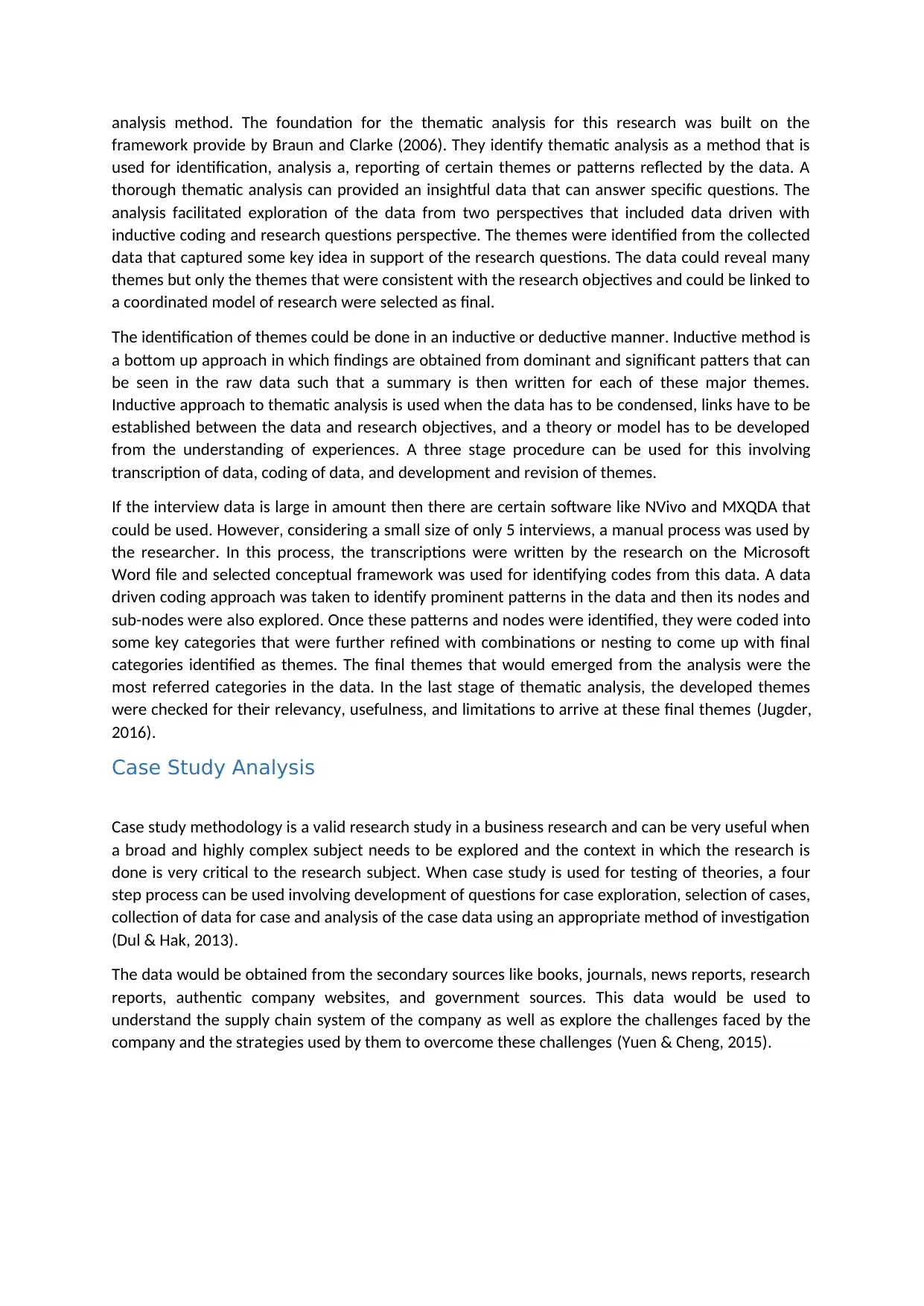
analysis method. The foundation for the thematic analysis for this research was built on the
framework provide by Braun and Clarke (2006). They identify thematic analysis as a method that is
used for identification, analysis a, reporting of certain themes or patterns reflected by the data. A
thorough thematic analysis can provided an insightful data that can answer specific questions. The
analysis facilitated exploration of the data from two perspectives that included data driven with
inductive coding and research questions perspective. The themes were identified from the collected
data that captured some key idea in support of the research questions. The data could reveal many
themes but only the themes that were consistent with the research objectives and could be linked to
a coordinated model of research were selected as final.
The identification of themes could be done in an inductive or deductive manner. Inductive method is
a bottom up approach in which findings are obtained from dominant and significant patters that can
be seen in the raw data such that a summary is then written for each of these major themes.
Inductive approach to thematic analysis is used when the data has to be condensed, links have to be
established between the data and research objectives, and a theory or model has to be developed
from the understanding of experiences. A three stage procedure can be used for this involving
transcription of data, coding of data, and development and revision of themes.
If the interview data is large in amount then there are certain software like NVivo and MXQDA that
could be used. However, considering a small size of only 5 interviews, a manual process was used by
the researcher. In this process, the transcriptions were written by the research on the Microsoft
Word file and selected conceptual framework was used for identifying codes from this data. A data
driven coding approach was taken to identify prominent patterns in the data and then its nodes and
sub-nodes were also explored. Once these patterns and nodes were identified, they were coded into
some key categories that were further refined with combinations or nesting to come up with final
categories identified as themes. The final themes that would emerged from the analysis were the
most referred categories in the data. In the last stage of thematic analysis, the developed themes
were checked for their relevancy, usefulness, and limitations to arrive at these final themes (Jugder,
2016).
Case Study Analysis
Case study methodology is a valid research study in a business research and can be very useful when
a broad and highly complex subject needs to be explored and the context in which the research is
done is very critical to the research subject. When case study is used for testing of theories, a four
step process can be used involving development of questions for case exploration, selection of cases,
collection of data for case and analysis of the case data using an appropriate method of investigation
(Dul & Hak, 2013).
The data would be obtained from the secondary sources like books, journals, news reports, research
reports, authentic company websites, and government sources. This data would be used to
understand the supply chain system of the company as well as explore the challenges faced by the
company and the strategies used by them to overcome these challenges (Yuen & Cheng, 2015).
framework provide by Braun and Clarke (2006). They identify thematic analysis as a method that is
used for identification, analysis a, reporting of certain themes or patterns reflected by the data. A
thorough thematic analysis can provided an insightful data that can answer specific questions. The
analysis facilitated exploration of the data from two perspectives that included data driven with
inductive coding and research questions perspective. The themes were identified from the collected
data that captured some key idea in support of the research questions. The data could reveal many
themes but only the themes that were consistent with the research objectives and could be linked to
a coordinated model of research were selected as final.
The identification of themes could be done in an inductive or deductive manner. Inductive method is
a bottom up approach in which findings are obtained from dominant and significant patters that can
be seen in the raw data such that a summary is then written for each of these major themes.
Inductive approach to thematic analysis is used when the data has to be condensed, links have to be
established between the data and research objectives, and a theory or model has to be developed
from the understanding of experiences. A three stage procedure can be used for this involving
transcription of data, coding of data, and development and revision of themes.
If the interview data is large in amount then there are certain software like NVivo and MXQDA that
could be used. However, considering a small size of only 5 interviews, a manual process was used by
the researcher. In this process, the transcriptions were written by the research on the Microsoft
Word file and selected conceptual framework was used for identifying codes from this data. A data
driven coding approach was taken to identify prominent patterns in the data and then its nodes and
sub-nodes were also explored. Once these patterns and nodes were identified, they were coded into
some key categories that were further refined with combinations or nesting to come up with final
categories identified as themes. The final themes that would emerged from the analysis were the
most referred categories in the data. In the last stage of thematic analysis, the developed themes
were checked for their relevancy, usefulness, and limitations to arrive at these final themes (Jugder,
2016).
Case Study Analysis
Case study methodology is a valid research study in a business research and can be very useful when
a broad and highly complex subject needs to be explored and the context in which the research is
done is very critical to the research subject. When case study is used for testing of theories, a four
step process can be used involving development of questions for case exploration, selection of cases,
collection of data for case and analysis of the case data using an appropriate method of investigation
(Dul & Hak, 2013).
The data would be obtained from the secondary sources like books, journals, news reports, research
reports, authentic company websites, and government sources. This data would be used to
understand the supply chain system of the company as well as explore the challenges faced by the
company and the strategies used by them to overcome these challenges (Yuen & Cheng, 2015).
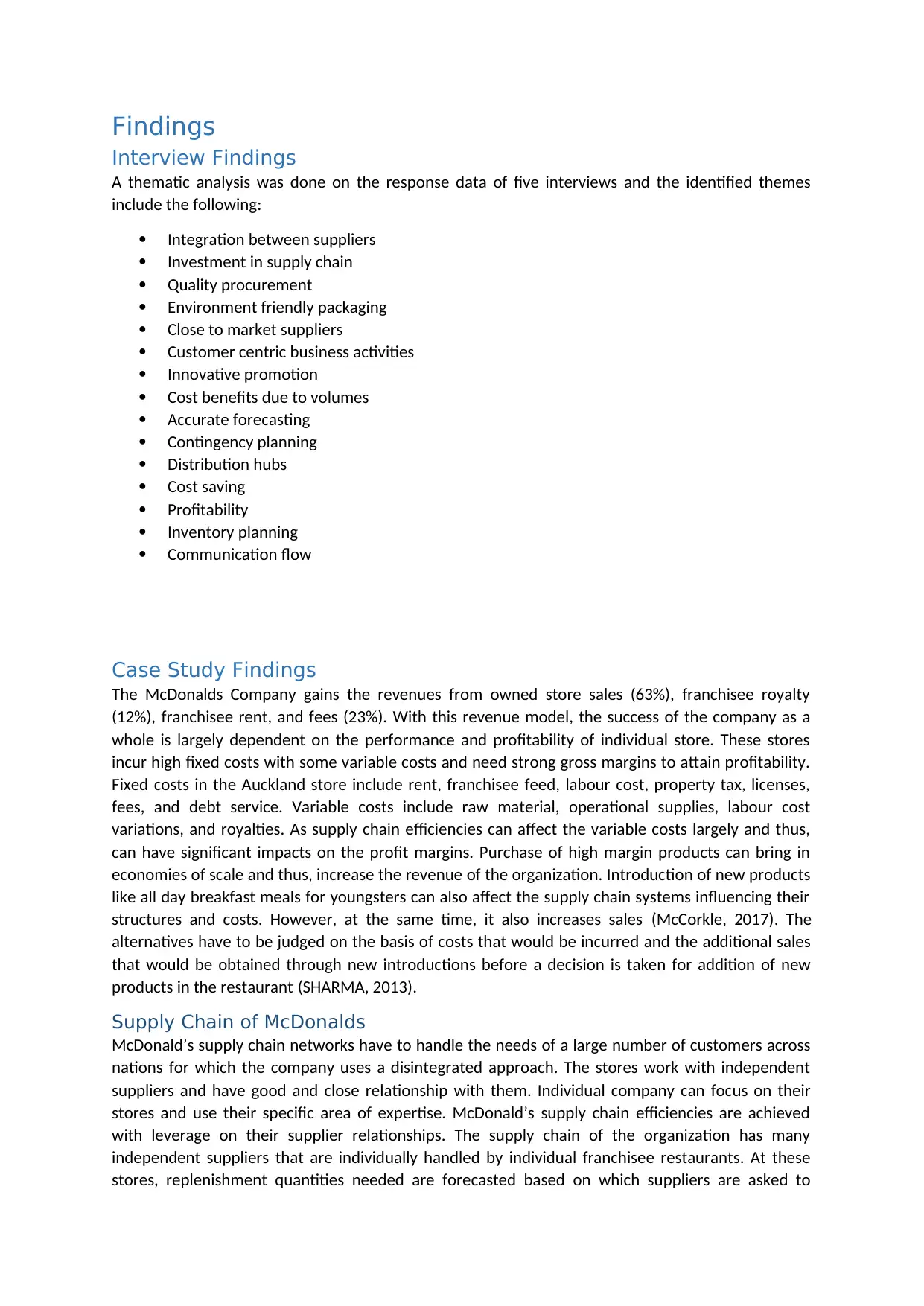
Findings
Interview Findings
A thematic analysis was done on the response data of five interviews and the identified themes
include the following:
Integration between suppliers
Investment in supply chain
Quality procurement
Environment friendly packaging
Close to market suppliers
Customer centric business activities
Innovative promotion
Cost benefits due to volumes
Accurate forecasting
Contingency planning
Distribution hubs
Cost saving
Profitability
Inventory planning
Communication flow
Case Study Findings
The McDonalds Company gains the revenues from owned store sales (63%), franchisee royalty
(12%), franchisee rent, and fees (23%). With this revenue model, the success of the company as a
whole is largely dependent on the performance and profitability of individual store. These stores
incur high fixed costs with some variable costs and need strong gross margins to attain profitability.
Fixed costs in the Auckland store include rent, franchisee feed, labour cost, property tax, licenses,
fees, and debt service. Variable costs include raw material, operational supplies, labour cost
variations, and royalties. As supply chain efficiencies can affect the variable costs largely and thus,
can have significant impacts on the profit margins. Purchase of high margin products can bring in
economies of scale and thus, increase the revenue of the organization. Introduction of new products
like all day breakfast meals for youngsters can also affect the supply chain systems influencing their
structures and costs. However, at the same time, it also increases sales (McCorkle, 2017). The
alternatives have to be judged on the basis of costs that would be incurred and the additional sales
that would be obtained through new introductions before a decision is taken for addition of new
products in the restaurant (SHARMA, 2013).
Supply Chain of McDonalds
McDonald’s supply chain networks have to handle the needs of a large number of customers across
nations for which the company uses a disintegrated approach. The stores work with independent
suppliers and have good and close relationship with them. Individual company can focus on their
stores and use their specific area of expertise. McDonald’s supply chain efficiencies are achieved
with leverage on their supplier relationships. The supply chain of the organization has many
independent suppliers that are individually handled by individual franchisee restaurants. At these
stores, replenishment quantities needed are forecasted based on which suppliers are asked to
Interview Findings
A thematic analysis was done on the response data of five interviews and the identified themes
include the following:
Integration between suppliers
Investment in supply chain
Quality procurement
Environment friendly packaging
Close to market suppliers
Customer centric business activities
Innovative promotion
Cost benefits due to volumes
Accurate forecasting
Contingency planning
Distribution hubs
Cost saving
Profitability
Inventory planning
Communication flow
Case Study Findings
The McDonalds Company gains the revenues from owned store sales (63%), franchisee royalty
(12%), franchisee rent, and fees (23%). With this revenue model, the success of the company as a
whole is largely dependent on the performance and profitability of individual store. These stores
incur high fixed costs with some variable costs and need strong gross margins to attain profitability.
Fixed costs in the Auckland store include rent, franchisee feed, labour cost, property tax, licenses,
fees, and debt service. Variable costs include raw material, operational supplies, labour cost
variations, and royalties. As supply chain efficiencies can affect the variable costs largely and thus,
can have significant impacts on the profit margins. Purchase of high margin products can bring in
economies of scale and thus, increase the revenue of the organization. Introduction of new products
like all day breakfast meals for youngsters can also affect the supply chain systems influencing their
structures and costs. However, at the same time, it also increases sales (McCorkle, 2017). The
alternatives have to be judged on the basis of costs that would be incurred and the additional sales
that would be obtained through new introductions before a decision is taken for addition of new
products in the restaurant (SHARMA, 2013).
Supply Chain of McDonalds
McDonald’s supply chain networks have to handle the needs of a large number of customers across
nations for which the company uses a disintegrated approach. The stores work with independent
suppliers and have good and close relationship with them. Individual company can focus on their
stores and use their specific area of expertise. McDonald’s supply chain efficiencies are achieved
with leverage on their supplier relationships. The supply chain of the organization has many
independent suppliers that are individually handled by individual franchisee restaurants. At these
stores, replenishment quantities needed are forecasted based on which suppliers are asked to
⊘ This is a preview!⊘
Do you want full access?
Subscribe today to unlock all pages.

Trusted by 1+ million students worldwide
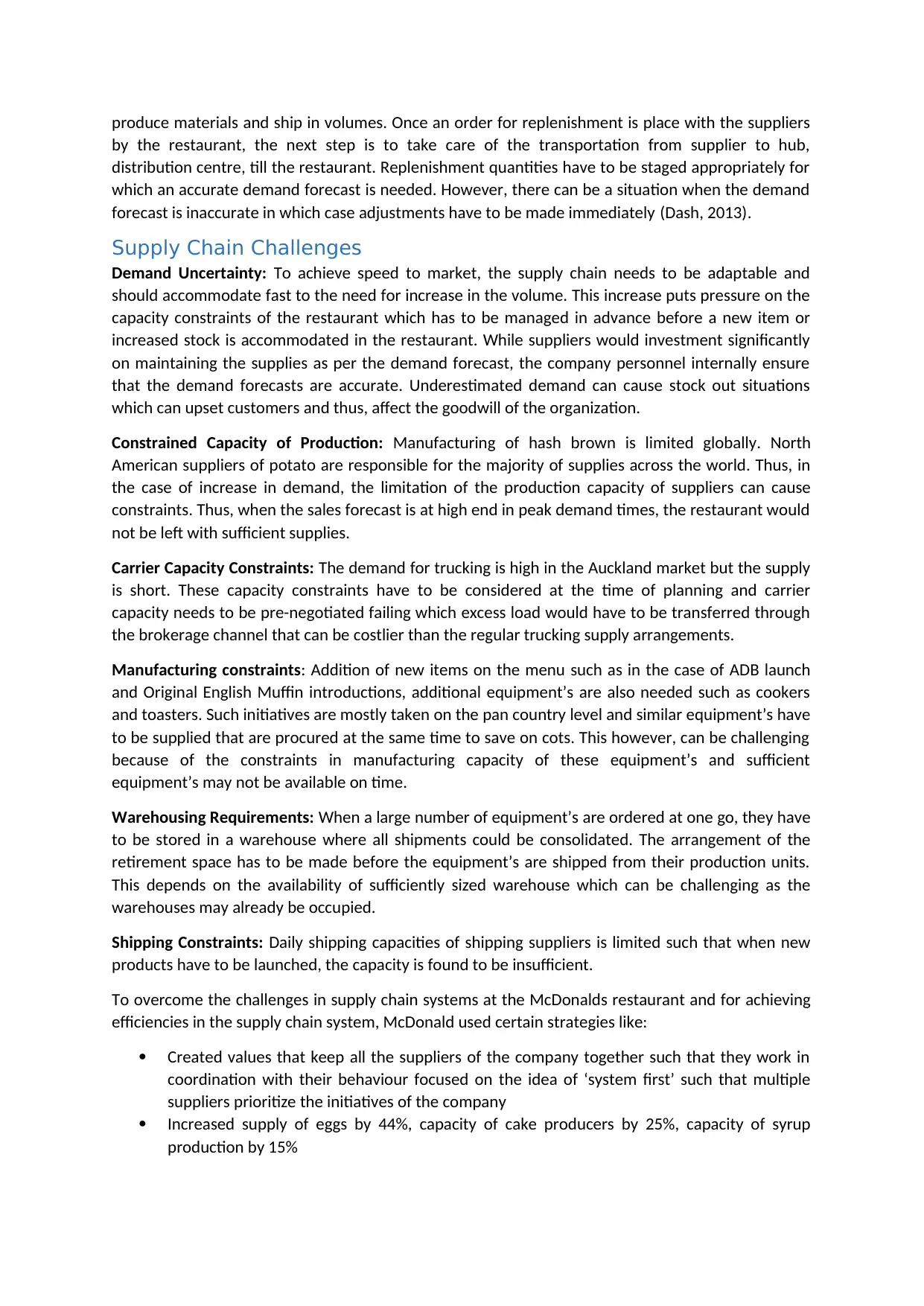
produce materials and ship in volumes. Once an order for replenishment is place with the suppliers
by the restaurant, the next step is to take care of the transportation from supplier to hub,
distribution centre, till the restaurant. Replenishment quantities have to be staged appropriately for
which an accurate demand forecast is needed. However, there can be a situation when the demand
forecast is inaccurate in which case adjustments have to be made immediately (Dash, 2013).
Supply Chain Challenges
Demand Uncertainty: To achieve speed to market, the supply chain needs to be adaptable and
should accommodate fast to the need for increase in the volume. This increase puts pressure on the
capacity constraints of the restaurant which has to be managed in advance before a new item or
increased stock is accommodated in the restaurant. While suppliers would investment significantly
on maintaining the supplies as per the demand forecast, the company personnel internally ensure
that the demand forecasts are accurate. Underestimated demand can cause stock out situations
which can upset customers and thus, affect the goodwill of the organization.
Constrained Capacity of Production: Manufacturing of hash brown is limited globally. North
American suppliers of potato are responsible for the majority of supplies across the world. Thus, in
the case of increase in demand, the limitation of the production capacity of suppliers can cause
constraints. Thus, when the sales forecast is at high end in peak demand times, the restaurant would
not be left with sufficient supplies.
Carrier Capacity Constraints: The demand for trucking is high in the Auckland market but the supply
is short. These capacity constraints have to be considered at the time of planning and carrier
capacity needs to be pre-negotiated failing which excess load would have to be transferred through
the brokerage channel that can be costlier than the regular trucking supply arrangements.
Manufacturing constraints: Addition of new items on the menu such as in the case of ADB launch
and Original English Muffin introductions, additional equipment’s are also needed such as cookers
and toasters. Such initiatives are mostly taken on the pan country level and similar equipment’s have
to be supplied that are procured at the same time to save on cots. This however, can be challenging
because of the constraints in manufacturing capacity of these equipment’s and sufficient
equipment’s may not be available on time.
Warehousing Requirements: When a large number of equipment’s are ordered at one go, they have
to be stored in a warehouse where all shipments could be consolidated. The arrangement of the
retirement space has to be made before the equipment’s are shipped from their production units.
This depends on the availability of sufficiently sized warehouse which can be challenging as the
warehouses may already be occupied.
Shipping Constraints: Daily shipping capacities of shipping suppliers is limited such that when new
products have to be launched, the capacity is found to be insufficient.
To overcome the challenges in supply chain systems at the McDonalds restaurant and for achieving
efficiencies in the supply chain system, McDonald used certain strategies like:
Created values that keep all the suppliers of the company together such that they work in
coordination with their behaviour focused on the idea of ‘system first’ such that multiple
suppliers prioritize the initiatives of the company
Increased supply of eggs by 44%, capacity of cake producers by 25%, capacity of syrup
production by 15%
by the restaurant, the next step is to take care of the transportation from supplier to hub,
distribution centre, till the restaurant. Replenishment quantities have to be staged appropriately for
which an accurate demand forecast is needed. However, there can be a situation when the demand
forecast is inaccurate in which case adjustments have to be made immediately (Dash, 2013).
Supply Chain Challenges
Demand Uncertainty: To achieve speed to market, the supply chain needs to be adaptable and
should accommodate fast to the need for increase in the volume. This increase puts pressure on the
capacity constraints of the restaurant which has to be managed in advance before a new item or
increased stock is accommodated in the restaurant. While suppliers would investment significantly
on maintaining the supplies as per the demand forecast, the company personnel internally ensure
that the demand forecasts are accurate. Underestimated demand can cause stock out situations
which can upset customers and thus, affect the goodwill of the organization.
Constrained Capacity of Production: Manufacturing of hash brown is limited globally. North
American suppliers of potato are responsible for the majority of supplies across the world. Thus, in
the case of increase in demand, the limitation of the production capacity of suppliers can cause
constraints. Thus, when the sales forecast is at high end in peak demand times, the restaurant would
not be left with sufficient supplies.
Carrier Capacity Constraints: The demand for trucking is high in the Auckland market but the supply
is short. These capacity constraints have to be considered at the time of planning and carrier
capacity needs to be pre-negotiated failing which excess load would have to be transferred through
the brokerage channel that can be costlier than the regular trucking supply arrangements.
Manufacturing constraints: Addition of new items on the menu such as in the case of ADB launch
and Original English Muffin introductions, additional equipment’s are also needed such as cookers
and toasters. Such initiatives are mostly taken on the pan country level and similar equipment’s have
to be supplied that are procured at the same time to save on cots. This however, can be challenging
because of the constraints in manufacturing capacity of these equipment’s and sufficient
equipment’s may not be available on time.
Warehousing Requirements: When a large number of equipment’s are ordered at one go, they have
to be stored in a warehouse where all shipments could be consolidated. The arrangement of the
retirement space has to be made before the equipment’s are shipped from their production units.
This depends on the availability of sufficiently sized warehouse which can be challenging as the
warehouses may already be occupied.
Shipping Constraints: Daily shipping capacities of shipping suppliers is limited such that when new
products have to be launched, the capacity is found to be insufficient.
To overcome the challenges in supply chain systems at the McDonalds restaurant and for achieving
efficiencies in the supply chain system, McDonald used certain strategies like:
Created values that keep all the suppliers of the company together such that they work in
coordination with their behaviour focused on the idea of ‘system first’ such that multiple
suppliers prioritize the initiatives of the company
Increased supply of eggs by 44%, capacity of cake producers by 25%, capacity of syrup
production by 15%
Paraphrase This Document
Need a fresh take? Get an instant paraphrase of this document with our AI Paraphraser
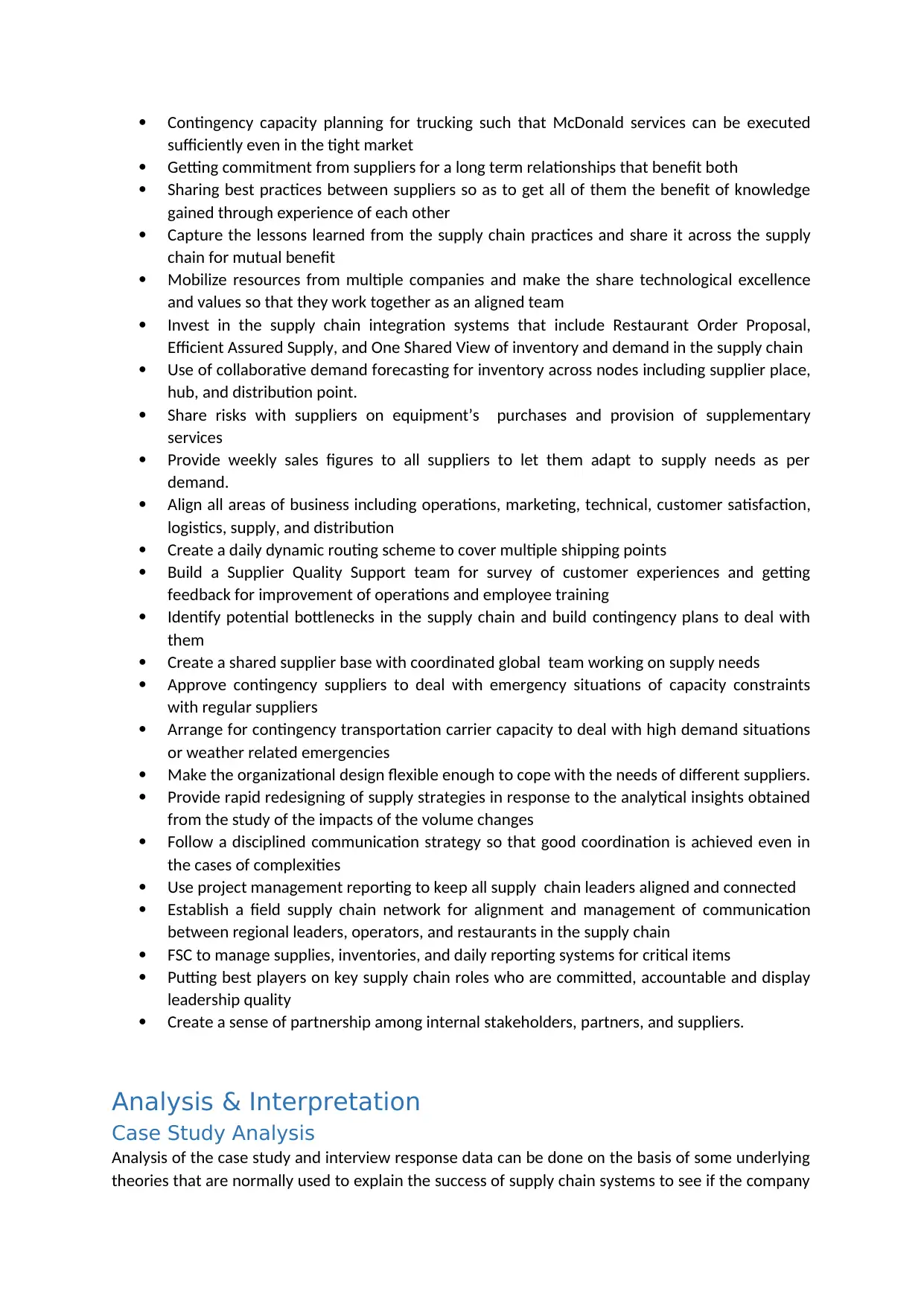
Contingency capacity planning for trucking such that McDonald services can be executed
sufficiently even in the tight market
Getting commitment from suppliers for a long term relationships that benefit both
Sharing best practices between suppliers so as to get all of them the benefit of knowledge
gained through experience of each other
Capture the lessons learned from the supply chain practices and share it across the supply
chain for mutual benefit
Mobilize resources from multiple companies and make the share technological excellence
and values so that they work together as an aligned team
Invest in the supply chain integration systems that include Restaurant Order Proposal,
Efficient Assured Supply, and One Shared View of inventory and demand in the supply chain
Use of collaborative demand forecasting for inventory across nodes including supplier place,
hub, and distribution point.
Share risks with suppliers on equipment’s purchases and provision of supplementary
services
Provide weekly sales figures to all suppliers to let them adapt to supply needs as per
demand.
Align all areas of business including operations, marketing, technical, customer satisfaction,
logistics, supply, and distribution
Create a daily dynamic routing scheme to cover multiple shipping points
Build a Supplier Quality Support team for survey of customer experiences and getting
feedback for improvement of operations and employee training
Identify potential bottlenecks in the supply chain and build contingency plans to deal with
them
Create a shared supplier base with coordinated global team working on supply needs
Approve contingency suppliers to deal with emergency situations of capacity constraints
with regular suppliers
Arrange for contingency transportation carrier capacity to deal with high demand situations
or weather related emergencies
Make the organizational design flexible enough to cope with the needs of different suppliers.
Provide rapid redesigning of supply strategies in response to the analytical insights obtained
from the study of the impacts of the volume changes
Follow a disciplined communication strategy so that good coordination is achieved even in
the cases of complexities
Use project management reporting to keep all supply chain leaders aligned and connected
Establish a field supply chain network for alignment and management of communication
between regional leaders, operators, and restaurants in the supply chain
FSC to manage supplies, inventories, and daily reporting systems for critical items
Putting best players on key supply chain roles who are committed, accountable and display
leadership quality
Create a sense of partnership among internal stakeholders, partners, and suppliers.
Analysis & Interpretation
Case Study Analysis
Analysis of the case study and interview response data can be done on the basis of some underlying
theories that are normally used to explain the success of supply chain systems to see if the company
sufficiently even in the tight market
Getting commitment from suppliers for a long term relationships that benefit both
Sharing best practices between suppliers so as to get all of them the benefit of knowledge
gained through experience of each other
Capture the lessons learned from the supply chain practices and share it across the supply
chain for mutual benefit
Mobilize resources from multiple companies and make the share technological excellence
and values so that they work together as an aligned team
Invest in the supply chain integration systems that include Restaurant Order Proposal,
Efficient Assured Supply, and One Shared View of inventory and demand in the supply chain
Use of collaborative demand forecasting for inventory across nodes including supplier place,
hub, and distribution point.
Share risks with suppliers on equipment’s purchases and provision of supplementary
services
Provide weekly sales figures to all suppliers to let them adapt to supply needs as per
demand.
Align all areas of business including operations, marketing, technical, customer satisfaction,
logistics, supply, and distribution
Create a daily dynamic routing scheme to cover multiple shipping points
Build a Supplier Quality Support team for survey of customer experiences and getting
feedback for improvement of operations and employee training
Identify potential bottlenecks in the supply chain and build contingency plans to deal with
them
Create a shared supplier base with coordinated global team working on supply needs
Approve contingency suppliers to deal with emergency situations of capacity constraints
with regular suppliers
Arrange for contingency transportation carrier capacity to deal with high demand situations
or weather related emergencies
Make the organizational design flexible enough to cope with the needs of different suppliers.
Provide rapid redesigning of supply strategies in response to the analytical insights obtained
from the study of the impacts of the volume changes
Follow a disciplined communication strategy so that good coordination is achieved even in
the cases of complexities
Use project management reporting to keep all supply chain leaders aligned and connected
Establish a field supply chain network for alignment and management of communication
between regional leaders, operators, and restaurants in the supply chain
FSC to manage supplies, inventories, and daily reporting systems for critical items
Putting best players on key supply chain roles who are committed, accountable and display
leadership quality
Create a sense of partnership among internal stakeholders, partners, and suppliers.
Analysis & Interpretation
Case Study Analysis
Analysis of the case study and interview response data can be done on the basis of some underlying
theories that are normally used to explain the success of supply chain systems to see if the company
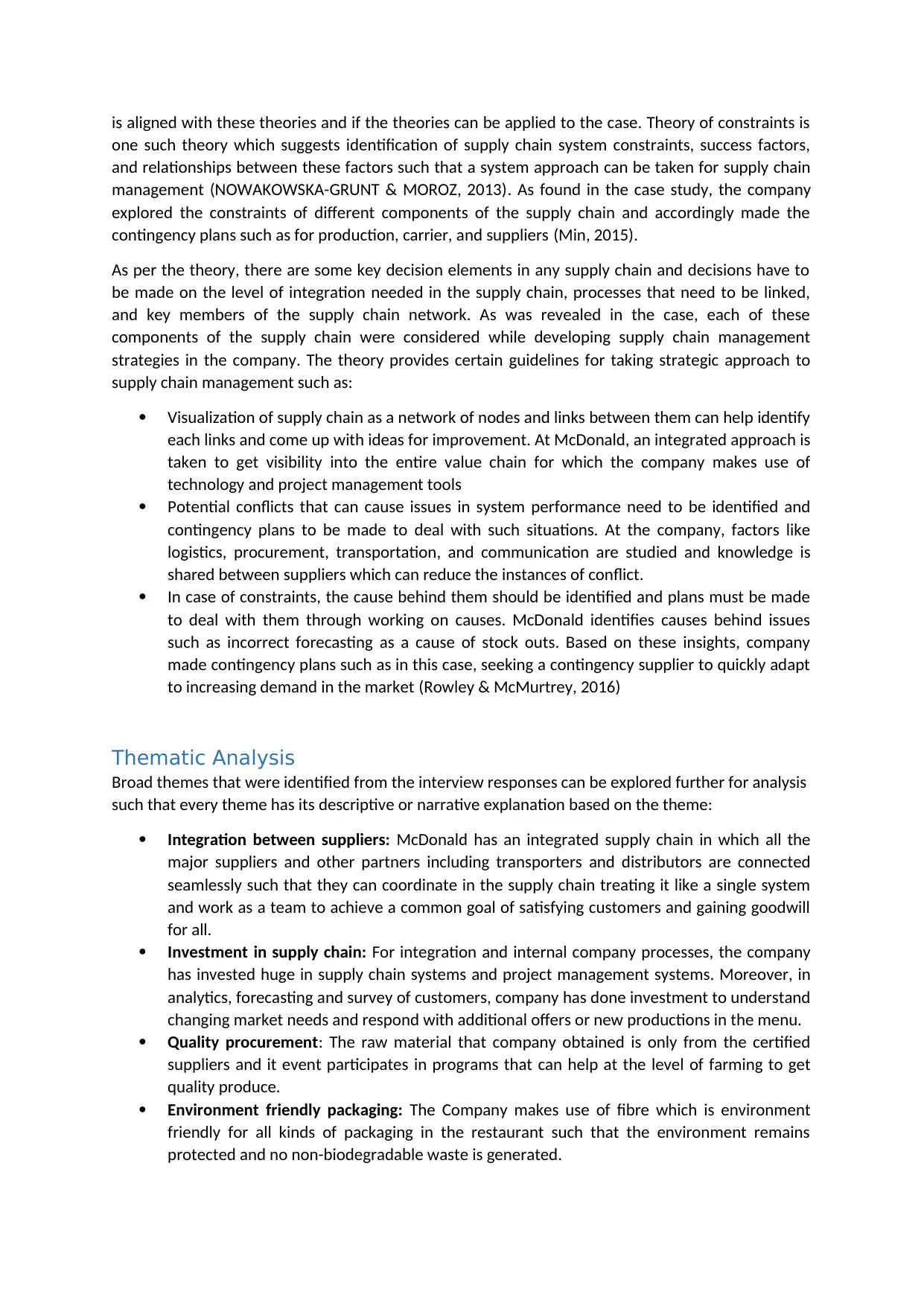
is aligned with these theories and if the theories can be applied to the case. Theory of constraints is
one such theory which suggests identification of supply chain system constraints, success factors,
and relationships between these factors such that a system approach can be taken for supply chain
management (NOWAKOWSKA-GRUNT & MOROZ, 2013). As found in the case study, the company
explored the constraints of different components of the supply chain and accordingly made the
contingency plans such as for production, carrier, and suppliers (Min, 2015).
As per the theory, there are some key decision elements in any supply chain and decisions have to
be made on the level of integration needed in the supply chain, processes that need to be linked,
and key members of the supply chain network. As was revealed in the case, each of these
components of the supply chain were considered while developing supply chain management
strategies in the company. The theory provides certain guidelines for taking strategic approach to
supply chain management such as:
Visualization of supply chain as a network of nodes and links between them can help identify
each links and come up with ideas for improvement. At McDonald, an integrated approach is
taken to get visibility into the entire value chain for which the company makes use of
technology and project management tools
Potential conflicts that can cause issues in system performance need to be identified and
contingency plans to be made to deal with such situations. At the company, factors like
logistics, procurement, transportation, and communication are studied and knowledge is
shared between suppliers which can reduce the instances of conflict.
In case of constraints, the cause behind them should be identified and plans must be made
to deal with them through working on causes. McDonald identifies causes behind issues
such as incorrect forecasting as a cause of stock outs. Based on these insights, company
made contingency plans such as in this case, seeking a contingency supplier to quickly adapt
to increasing demand in the market (Rowley & McMurtrey, 2016)
Thematic Analysis
Broad themes that were identified from the interview responses can be explored further for analysis
such that every theme has its descriptive or narrative explanation based on the theme:
Integration between suppliers: McDonald has an integrated supply chain in which all the
major suppliers and other partners including transporters and distributors are connected
seamlessly such that they can coordinate in the supply chain treating it like a single system
and work as a team to achieve a common goal of satisfying customers and gaining goodwill
for all.
Investment in supply chain: For integration and internal company processes, the company
has invested huge in supply chain systems and project management systems. Moreover, in
analytics, forecasting and survey of customers, company has done investment to understand
changing market needs and respond with additional offers or new productions in the menu.
Quality procurement: The raw material that company obtained is only from the certified
suppliers and it event participates in programs that can help at the level of farming to get
quality produce.
Environment friendly packaging: The Company makes use of fibre which is environment
friendly for all kinds of packaging in the restaurant such that the environment remains
protected and no non-biodegradable waste is generated.
one such theory which suggests identification of supply chain system constraints, success factors,
and relationships between these factors such that a system approach can be taken for supply chain
management (NOWAKOWSKA-GRUNT & MOROZ, 2013). As found in the case study, the company
explored the constraints of different components of the supply chain and accordingly made the
contingency plans such as for production, carrier, and suppliers (Min, 2015).
As per the theory, there are some key decision elements in any supply chain and decisions have to
be made on the level of integration needed in the supply chain, processes that need to be linked,
and key members of the supply chain network. As was revealed in the case, each of these
components of the supply chain were considered while developing supply chain management
strategies in the company. The theory provides certain guidelines for taking strategic approach to
supply chain management such as:
Visualization of supply chain as a network of nodes and links between them can help identify
each links and come up with ideas for improvement. At McDonald, an integrated approach is
taken to get visibility into the entire value chain for which the company makes use of
technology and project management tools
Potential conflicts that can cause issues in system performance need to be identified and
contingency plans to be made to deal with such situations. At the company, factors like
logistics, procurement, transportation, and communication are studied and knowledge is
shared between suppliers which can reduce the instances of conflict.
In case of constraints, the cause behind them should be identified and plans must be made
to deal with them through working on causes. McDonald identifies causes behind issues
such as incorrect forecasting as a cause of stock outs. Based on these insights, company
made contingency plans such as in this case, seeking a contingency supplier to quickly adapt
to increasing demand in the market (Rowley & McMurtrey, 2016)
Thematic Analysis
Broad themes that were identified from the interview responses can be explored further for analysis
such that every theme has its descriptive or narrative explanation based on the theme:
Integration between suppliers: McDonald has an integrated supply chain in which all the
major suppliers and other partners including transporters and distributors are connected
seamlessly such that they can coordinate in the supply chain treating it like a single system
and work as a team to achieve a common goal of satisfying customers and gaining goodwill
for all.
Investment in supply chain: For integration and internal company processes, the company
has invested huge in supply chain systems and project management systems. Moreover, in
analytics, forecasting and survey of customers, company has done investment to understand
changing market needs and respond with additional offers or new productions in the menu.
Quality procurement: The raw material that company obtained is only from the certified
suppliers and it event participates in programs that can help at the level of farming to get
quality produce.
Environment friendly packaging: The Company makes use of fibre which is environment
friendly for all kinds of packaging in the restaurant such that the environment remains
protected and no non-biodegradable waste is generated.
⊘ This is a preview!⊘
Do you want full access?
Subscribe today to unlock all pages.

Trusted by 1+ million students worldwide
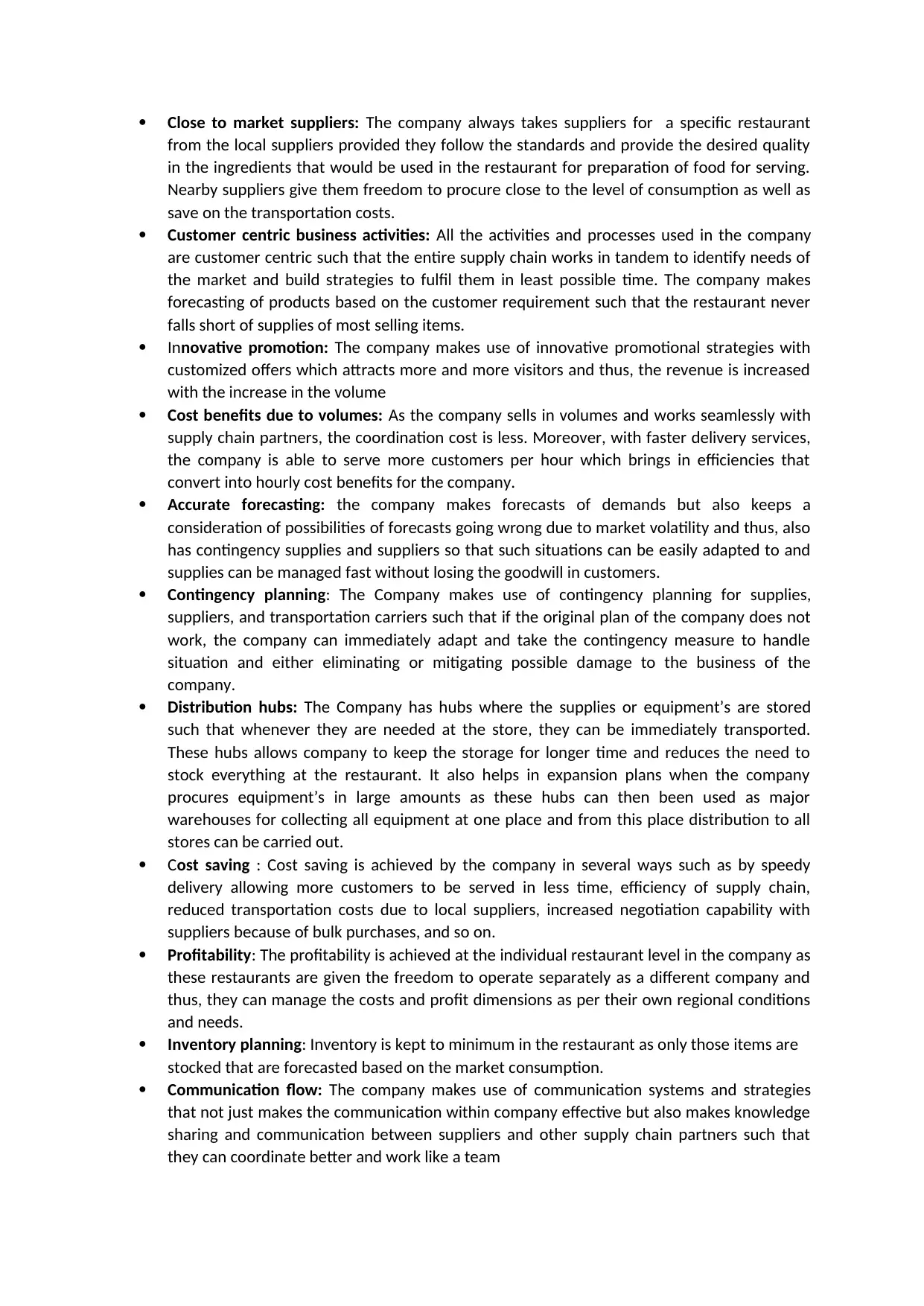
Close to market suppliers: The company always takes suppliers for a specific restaurant
from the local suppliers provided they follow the standards and provide the desired quality
in the ingredients that would be used in the restaurant for preparation of food for serving.
Nearby suppliers give them freedom to procure close to the level of consumption as well as
save on the transportation costs.
Customer centric business activities: All the activities and processes used in the company
are customer centric such that the entire supply chain works in tandem to identify needs of
the market and build strategies to fulfil them in least possible time. The company makes
forecasting of products based on the customer requirement such that the restaurant never
falls short of supplies of most selling items.
Innovative promotion: The company makes use of innovative promotional strategies with
customized offers which attracts more and more visitors and thus, the revenue is increased
with the increase in the volume
Cost benefits due to volumes: As the company sells in volumes and works seamlessly with
supply chain partners, the coordination cost is less. Moreover, with faster delivery services,
the company is able to serve more customers per hour which brings in efficiencies that
convert into hourly cost benefits for the company.
Accurate forecasting: the company makes forecasts of demands but also keeps a
consideration of possibilities of forecasts going wrong due to market volatility and thus, also
has contingency supplies and suppliers so that such situations can be easily adapted to and
supplies can be managed fast without losing the goodwill in customers.
Contingency planning: The Company makes use of contingency planning for supplies,
suppliers, and transportation carriers such that if the original plan of the company does not
work, the company can immediately adapt and take the contingency measure to handle
situation and either eliminating or mitigating possible damage to the business of the
company.
Distribution hubs: The Company has hubs where the supplies or equipment’s are stored
such that whenever they are needed at the store, they can be immediately transported.
These hubs allows company to keep the storage for longer time and reduces the need to
stock everything at the restaurant. It also helps in expansion plans when the company
procures equipment’s in large amounts as these hubs can then been used as major
warehouses for collecting all equipment at one place and from this place distribution to all
stores can be carried out.
Cost saving : Cost saving is achieved by the company in several ways such as by speedy
delivery allowing more customers to be served in less time, efficiency of supply chain,
reduced transportation costs due to local suppliers, increased negotiation capability with
suppliers because of bulk purchases, and so on.
Profitability: The profitability is achieved at the individual restaurant level in the company as
these restaurants are given the freedom to operate separately as a different company and
thus, they can manage the costs and profit dimensions as per their own regional conditions
and needs.
Inventory planning: Inventory is kept to minimum in the restaurant as only those items are
stocked that are forecasted based on the market consumption.
Communication flow: The company makes use of communication systems and strategies
that not just makes the communication within company effective but also makes knowledge
sharing and communication between suppliers and other supply chain partners such that
they can coordinate better and work like a team
from the local suppliers provided they follow the standards and provide the desired quality
in the ingredients that would be used in the restaurant for preparation of food for serving.
Nearby suppliers give them freedom to procure close to the level of consumption as well as
save on the transportation costs.
Customer centric business activities: All the activities and processes used in the company
are customer centric such that the entire supply chain works in tandem to identify needs of
the market and build strategies to fulfil them in least possible time. The company makes
forecasting of products based on the customer requirement such that the restaurant never
falls short of supplies of most selling items.
Innovative promotion: The company makes use of innovative promotional strategies with
customized offers which attracts more and more visitors and thus, the revenue is increased
with the increase in the volume
Cost benefits due to volumes: As the company sells in volumes and works seamlessly with
supply chain partners, the coordination cost is less. Moreover, with faster delivery services,
the company is able to serve more customers per hour which brings in efficiencies that
convert into hourly cost benefits for the company.
Accurate forecasting: the company makes forecasts of demands but also keeps a
consideration of possibilities of forecasts going wrong due to market volatility and thus, also
has contingency supplies and suppliers so that such situations can be easily adapted to and
supplies can be managed fast without losing the goodwill in customers.
Contingency planning: The Company makes use of contingency planning for supplies,
suppliers, and transportation carriers such that if the original plan of the company does not
work, the company can immediately adapt and take the contingency measure to handle
situation and either eliminating or mitigating possible damage to the business of the
company.
Distribution hubs: The Company has hubs where the supplies or equipment’s are stored
such that whenever they are needed at the store, they can be immediately transported.
These hubs allows company to keep the storage for longer time and reduces the need to
stock everything at the restaurant. It also helps in expansion plans when the company
procures equipment’s in large amounts as these hubs can then been used as major
warehouses for collecting all equipment at one place and from this place distribution to all
stores can be carried out.
Cost saving : Cost saving is achieved by the company in several ways such as by speedy
delivery allowing more customers to be served in less time, efficiency of supply chain,
reduced transportation costs due to local suppliers, increased negotiation capability with
suppliers because of bulk purchases, and so on.
Profitability: The profitability is achieved at the individual restaurant level in the company as
these restaurants are given the freedom to operate separately as a different company and
thus, they can manage the costs and profit dimensions as per their own regional conditions
and needs.
Inventory planning: Inventory is kept to minimum in the restaurant as only those items are
stocked that are forecasted based on the market consumption.
Communication flow: The company makes use of communication systems and strategies
that not just makes the communication within company effective but also makes knowledge
sharing and communication between suppliers and other supply chain partners such that
they can coordinate better and work like a team
Paraphrase This Document
Need a fresh take? Get an instant paraphrase of this document with our AI Paraphraser
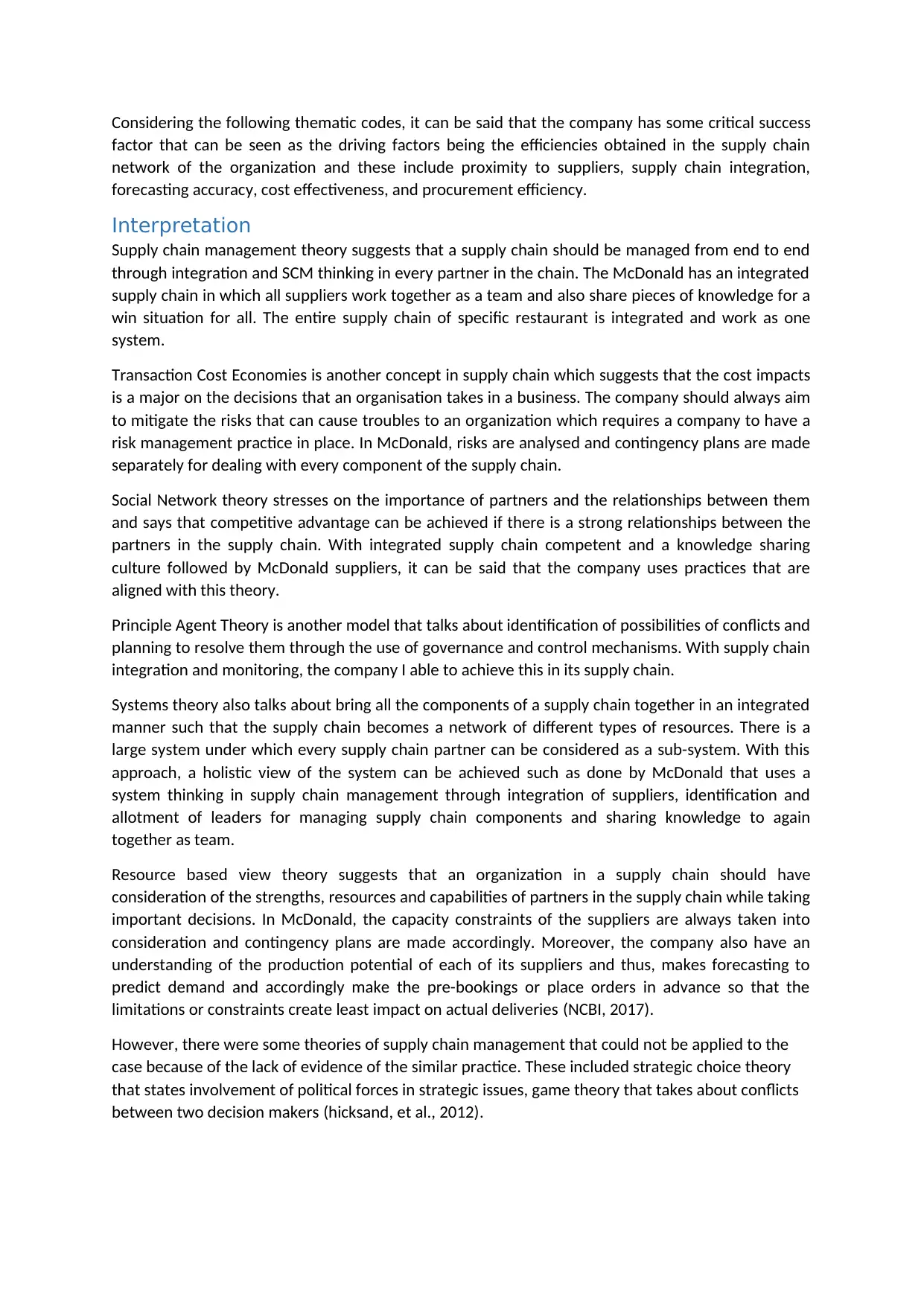
Considering the following thematic codes, it can be said that the company has some critical success
factor that can be seen as the driving factors being the efficiencies obtained in the supply chain
network of the organization and these include proximity to suppliers, supply chain integration,
forecasting accuracy, cost effectiveness, and procurement efficiency.
Interpretation
Supply chain management theory suggests that a supply chain should be managed from end to end
through integration and SCM thinking in every partner in the chain. The McDonald has an integrated
supply chain in which all suppliers work together as a team and also share pieces of knowledge for a
win situation for all. The entire supply chain of specific restaurant is integrated and work as one
system.
Transaction Cost Economies is another concept in supply chain which suggests that the cost impacts
is a major on the decisions that an organisation takes in a business. The company should always aim
to mitigate the risks that can cause troubles to an organization which requires a company to have a
risk management practice in place. In McDonald, risks are analysed and contingency plans are made
separately for dealing with every component of the supply chain.
Social Network theory stresses on the importance of partners and the relationships between them
and says that competitive advantage can be achieved if there is a strong relationships between the
partners in the supply chain. With integrated supply chain competent and a knowledge sharing
culture followed by McDonald suppliers, it can be said that the company uses practices that are
aligned with this theory.
Principle Agent Theory is another model that talks about identification of possibilities of conflicts and
planning to resolve them through the use of governance and control mechanisms. With supply chain
integration and monitoring, the company I able to achieve this in its supply chain.
Systems theory also talks about bring all the components of a supply chain together in an integrated
manner such that the supply chain becomes a network of different types of resources. There is a
large system under which every supply chain partner can be considered as a sub-system. With this
approach, a holistic view of the system can be achieved such as done by McDonald that uses a
system thinking in supply chain management through integration of suppliers, identification and
allotment of leaders for managing supply chain components and sharing knowledge to again
together as team.
Resource based view theory suggests that an organization in a supply chain should have
consideration of the strengths, resources and capabilities of partners in the supply chain while taking
important decisions. In McDonald, the capacity constraints of the suppliers are always taken into
consideration and contingency plans are made accordingly. Moreover, the company also have an
understanding of the production potential of each of its suppliers and thus, makes forecasting to
predict demand and accordingly make the pre-bookings or place orders in advance so that the
limitations or constraints create least impact on actual deliveries (NCBI, 2017).
However, there were some theories of supply chain management that could not be applied to the
case because of the lack of evidence of the similar practice. These included strategic choice theory
that states involvement of political forces in strategic issues, game theory that takes about conflicts
between two decision makers (hicksand, et al., 2012).
factor that can be seen as the driving factors being the efficiencies obtained in the supply chain
network of the organization and these include proximity to suppliers, supply chain integration,
forecasting accuracy, cost effectiveness, and procurement efficiency.
Interpretation
Supply chain management theory suggests that a supply chain should be managed from end to end
through integration and SCM thinking in every partner in the chain. The McDonald has an integrated
supply chain in which all suppliers work together as a team and also share pieces of knowledge for a
win situation for all. The entire supply chain of specific restaurant is integrated and work as one
system.
Transaction Cost Economies is another concept in supply chain which suggests that the cost impacts
is a major on the decisions that an organisation takes in a business. The company should always aim
to mitigate the risks that can cause troubles to an organization which requires a company to have a
risk management practice in place. In McDonald, risks are analysed and contingency plans are made
separately for dealing with every component of the supply chain.
Social Network theory stresses on the importance of partners and the relationships between them
and says that competitive advantage can be achieved if there is a strong relationships between the
partners in the supply chain. With integrated supply chain competent and a knowledge sharing
culture followed by McDonald suppliers, it can be said that the company uses practices that are
aligned with this theory.
Principle Agent Theory is another model that talks about identification of possibilities of conflicts and
planning to resolve them through the use of governance and control mechanisms. With supply chain
integration and monitoring, the company I able to achieve this in its supply chain.
Systems theory also talks about bring all the components of a supply chain together in an integrated
manner such that the supply chain becomes a network of different types of resources. There is a
large system under which every supply chain partner can be considered as a sub-system. With this
approach, a holistic view of the system can be achieved such as done by McDonald that uses a
system thinking in supply chain management through integration of suppliers, identification and
allotment of leaders for managing supply chain components and sharing knowledge to again
together as team.
Resource based view theory suggests that an organization in a supply chain should have
consideration of the strengths, resources and capabilities of partners in the supply chain while taking
important decisions. In McDonald, the capacity constraints of the suppliers are always taken into
consideration and contingency plans are made accordingly. Moreover, the company also have an
understanding of the production potential of each of its suppliers and thus, makes forecasting to
predict demand and accordingly make the pre-bookings or place orders in advance so that the
limitations or constraints create least impact on actual deliveries (NCBI, 2017).
However, there were some theories of supply chain management that could not be applied to the
case because of the lack of evidence of the similar practice. These included strategic choice theory
that states involvement of political forces in strategic issues, game theory that takes about conflicts
between two decision makers (hicksand, et al., 2012).
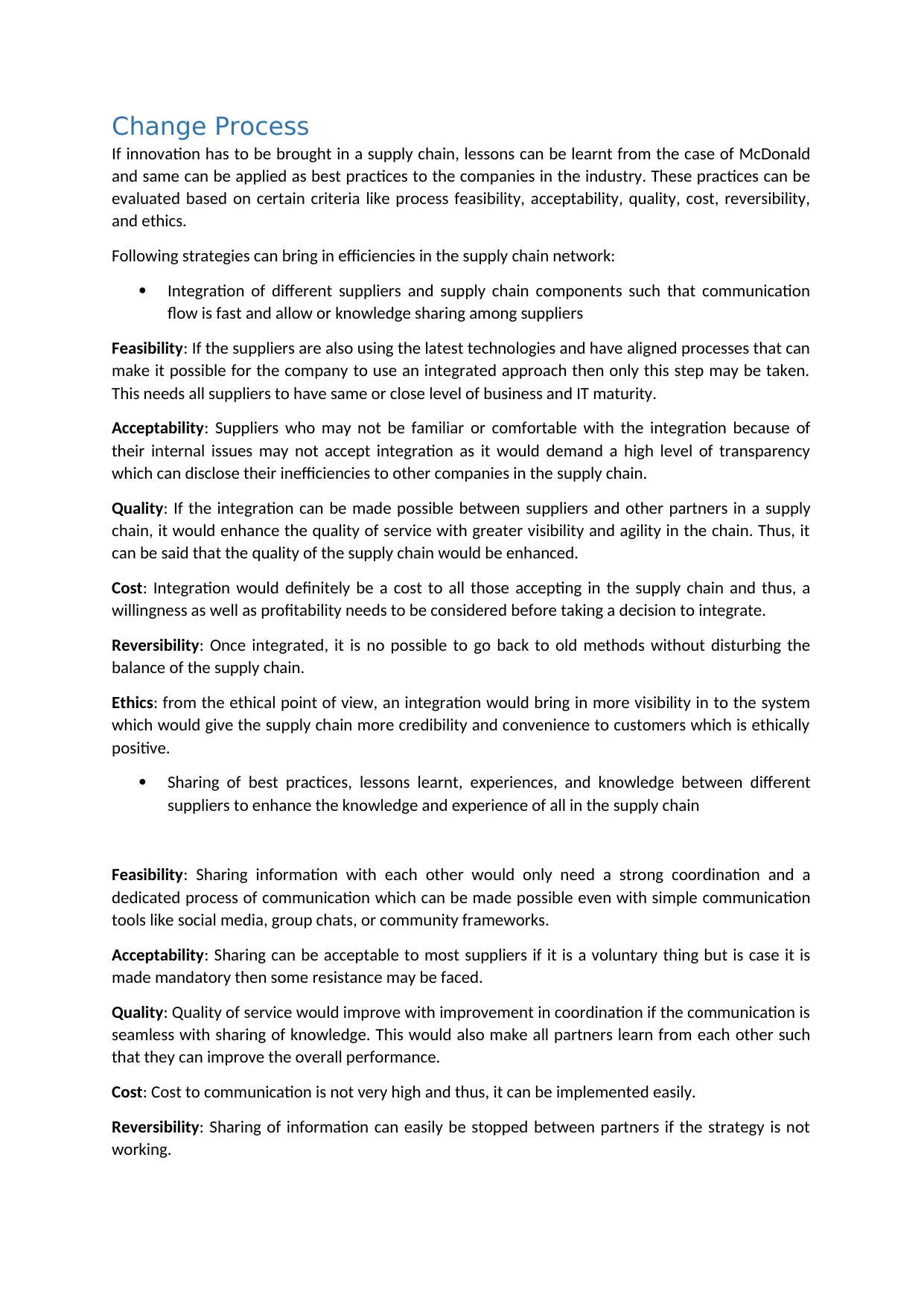
Change Process
If innovation has to be brought in a supply chain, lessons can be learnt from the case of McDonald
and same can be applied as best practices to the companies in the industry. These practices can be
evaluated based on certain criteria like process feasibility, acceptability, quality, cost, reversibility,
and ethics.
Following strategies can bring in efficiencies in the supply chain network:
Integration of different suppliers and supply chain components such that communication
flow is fast and allow or knowledge sharing among suppliers
Feasibility: If the suppliers are also using the latest technologies and have aligned processes that can
make it possible for the company to use an integrated approach then only this step may be taken.
This needs all suppliers to have same or close level of business and IT maturity.
Acceptability: Suppliers who may not be familiar or comfortable with the integration because of
their internal issues may not accept integration as it would demand a high level of transparency
which can disclose their inefficiencies to other companies in the supply chain.
Quality: If the integration can be made possible between suppliers and other partners in a supply
chain, it would enhance the quality of service with greater visibility and agility in the chain. Thus, it
can be said that the quality of the supply chain would be enhanced.
Cost: Integration would definitely be a cost to all those accepting in the supply chain and thus, a
willingness as well as profitability needs to be considered before taking a decision to integrate.
Reversibility: Once integrated, it is no possible to go back to old methods without disturbing the
balance of the supply chain.
Ethics: from the ethical point of view, an integration would bring in more visibility in to the system
which would give the supply chain more credibility and convenience to customers which is ethically
positive.
Sharing of best practices, lessons learnt, experiences, and knowledge between different
suppliers to enhance the knowledge and experience of all in the supply chain
Feasibility: Sharing information with each other would only need a strong coordination and a
dedicated process of communication which can be made possible even with simple communication
tools like social media, group chats, or community frameworks.
Acceptability: Sharing can be acceptable to most suppliers if it is a voluntary thing but is case it is
made mandatory then some resistance may be faced.
Quality: Quality of service would improve with improvement in coordination if the communication is
seamless with sharing of knowledge. This would also make all partners learn from each other such
that they can improve the overall performance.
Cost: Cost to communication is not very high and thus, it can be implemented easily.
Reversibility: Sharing of information can easily be stopped between partners if the strategy is not
working.
If innovation has to be brought in a supply chain, lessons can be learnt from the case of McDonald
and same can be applied as best practices to the companies in the industry. These practices can be
evaluated based on certain criteria like process feasibility, acceptability, quality, cost, reversibility,
and ethics.
Following strategies can bring in efficiencies in the supply chain network:
Integration of different suppliers and supply chain components such that communication
flow is fast and allow or knowledge sharing among suppliers
Feasibility: If the suppliers are also using the latest technologies and have aligned processes that can
make it possible for the company to use an integrated approach then only this step may be taken.
This needs all suppliers to have same or close level of business and IT maturity.
Acceptability: Suppliers who may not be familiar or comfortable with the integration because of
their internal issues may not accept integration as it would demand a high level of transparency
which can disclose their inefficiencies to other companies in the supply chain.
Quality: If the integration can be made possible between suppliers and other partners in a supply
chain, it would enhance the quality of service with greater visibility and agility in the chain. Thus, it
can be said that the quality of the supply chain would be enhanced.
Cost: Integration would definitely be a cost to all those accepting in the supply chain and thus, a
willingness as well as profitability needs to be considered before taking a decision to integrate.
Reversibility: Once integrated, it is no possible to go back to old methods without disturbing the
balance of the supply chain.
Ethics: from the ethical point of view, an integration would bring in more visibility in to the system
which would give the supply chain more credibility and convenience to customers which is ethically
positive.
Sharing of best practices, lessons learnt, experiences, and knowledge between different
suppliers to enhance the knowledge and experience of all in the supply chain
Feasibility: Sharing information with each other would only need a strong coordination and a
dedicated process of communication which can be made possible even with simple communication
tools like social media, group chats, or community frameworks.
Acceptability: Sharing can be acceptable to most suppliers if it is a voluntary thing but is case it is
made mandatory then some resistance may be faced.
Quality: Quality of service would improve with improvement in coordination if the communication is
seamless with sharing of knowledge. This would also make all partners learn from each other such
that they can improve the overall performance.
Cost: Cost to communication is not very high and thus, it can be implemented easily.
Reversibility: Sharing of information can easily be stopped between partners if the strategy is not
working.
⊘ This is a preview!⊘
Do you want full access?
Subscribe today to unlock all pages.

Trusted by 1+ million students worldwide
1 out of 17
Related Documents
Your All-in-One AI-Powered Toolkit for Academic Success.
+13062052269
info@desklib.com
Available 24*7 on WhatsApp / Email
![[object Object]](/_next/static/media/star-bottom.7253800d.svg)
Unlock your academic potential
Copyright © 2020–2025 A2Z Services. All Rights Reserved. Developed and managed by ZUCOL.



